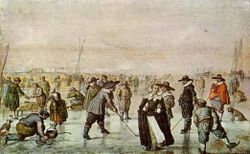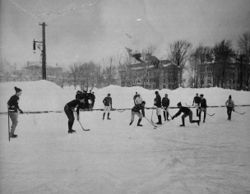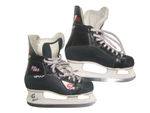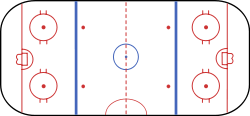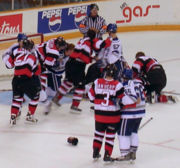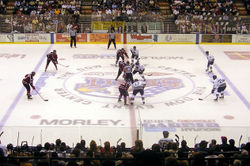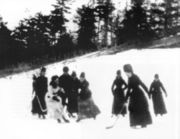Ice hockey
2007 Schools Wikipedia Selection. Related subjects: Sports
Ice hockey, referred to simply as hockey in Canada and the United States, is a team sport played on ice. While there are 64 total members of the International Ice Hockey Federation (IIHF), Canada, the Czech Republic, Finland, Russia, Slovakia, Sweden and the United States have finished within most of the coveted 1st, 2nd and 3rd places at IIHF World Championships. Of the sixty medals awarded in men's competition at the Olympic level from 1920 on, only six did not go to the one of those countries, or a former entity thereof, such as Czechoslovakia or the Soviet Union. Only one of those six medals was above bronze. Those seven nations have also captured 221 of 240 medals awarded during the 80 years the IIHF World Championships has been played. Also deserving a notable mention is Switzerland, which has won 2 bronze medals at the Olympics and finished in third place 7 times at other IIHF World Championships. Switzerland also maintains one of the oldest and top-rated ice hockey leagues ( The Swiss Nationalliga) outside of the NHL.
Ice hockey is most popular as a sport in areas that are sufficiently cold for natural, reliable seasonal ice cover. It is one of the four major North American professional sports, represented by the National Hockey League (NHL) at the highest level. It is the official national winter sport of Canada, where the game enjoys immense popularity, and is also the most popular spectator sport in Finland. Six of the thirty NHL franchises are based in Canada, but Canadians outnumber Americans in the league by a ratio of almost four to one. About thirty percent of the league's players are non-North American. The sport's popularity in the U.S. is concentrated in certain regions, notably the Northeast, the Upper Midwest, and Alaska. This concentration helps to make ice hockey the least watched major sport in the United States, however it is by far the most watched in Canada. Nonetheless, in certain major U.S. cities (notably Buffalo, Detroit, Pittsburgh, Minneapolis, Chicago, Boston, Dallas, New York City, Philadelphia, and Denver) it is still a major competitor to basketball for winter sports fans.
Ice hockey is a physically demanding sport, due to the high tempo and quick changes in puck possession during a typical game. On a full-sized rink, a player who merely coasts or who is relatively stationary will be of little use to his or her team. Hence, shifts typically last from fifteen to sixty seconds in a competitive game.
History
Games between teams hitting an object with curved sticks have been played throughout history; 4000 year-old drawings at the Beni-Hasen tombs in Egypt depict a sport resembling Field hockey. The 1527 Galway Statutes in Ireland made reference to "the horlinge of the litill balle with hockie stickes or staves." The etymology of the word hockey is uncertain. It may derive from the Old French word hoquet, shepherd's crook, or from the Middle Dutch word hokkie, meaning shack or doghouse, which in popular use meant goal. Many of these games were developed for fields, though where conditions allowed they were also played on ice. 16th-century Dutch paintings show townsfolk playing a hockey-like game on a frozen canal.
European immigrants brought various versions of hockey-like games to North America, such as the Scottish sport of shinty, the closely-related Irish sport of hurling, and versions of field hockey played in England. Where necessary these seem to have been adapted for icy conditions; for example, a colonial Williamsburg newspaper records hockey being played in a snow storm in Virginia. Both English- and French-speaking Canadians played hockey on frozen rivers, lakes, and ponds using cheese cutters strapped to their boots, and early paintings show hockey being played in Nova Scotia. Author Thomas Chandler Haliburton wrote of boys from King's College School in Windsor, Nova Scotia, playing "hurley on the ice" when he was a student there around 1800. These early games may have absorbed the physically aggressive aspects of what the Mi'kmaq Aboriginal First Nation in Nova Scotia called dehuntshigwa'es ( lacrosse).
In 1825 Sir John Franklin wrote that "The game of hockey played on the ice was the morning sport" while on Great Bear Lake during one of his Arctic expeditions. In 1843 a British Army officer in Kingston, Ontario, wrote "Began to skate this year, improved quickly and had great fun at hockey on the ice." The Society for International Hockey Research contends, based on a Boston Evening Gazette article from 1859, that an early game of hockey on ice occurred in Halifax in that year. The first game to use a puck rather than a ball took place in 1860 on Kingston Harbour, involving mostly Crimean War veterans.
Based on Haliburton's writings, there have been claims that modern ice hockey originated in Windsor, Nova Scotia, and was named after an individual, as in 'Colonel Hockey's game'. Proponents of this theory state that the surname Hockey exists in the district surrounding Windsor. In 1943, the Canadian Amateur Hockey Association declared Kingston the birthplace of hockey, based on a recorded 1886 game played between students of Queen's University and the Royal Military College of Canada.
Foundation of the modern game
The development of the modern game centered on Montreal. On March 3, 1875 the first organized indoor game was played at Montreal's Victoria Rink by James Creighton and several McGill University students. In 1877, several McGill students, including Creighton, Henry Joseph, Richard F. Smith, W.F. Robertson, and W.L. Murray codified seven ice hockey rules. The first ice hockey club, McGill University Hockey Club, was founded in 1880.
The game became so popular that it was featured in Montreal's annual Winter Carnival in 1883. In 1885, A.P. Low introduced the game to Ottawa. During the same year, the Oxford University Ice Hockey Club was formed to play the first Varsity Match against traditional rival Cambridge in St. Moritz, Switzerland. This match was won by the Oxford Dark Blues, 6-0. The first photographs and team lists date from 1895. This continues to be the oldest hockey rivalry in history.
In 1888 the new Governor General of Canada, Lord Stanley of Preston, whose sons and daughter became hockey enthusiasts, attended the Carnival and was impressed with the hockey spectacle. In 1892, recognizing that there was no recognition for the best team, he purchased a decorative bowl for use as a trophy. This trophy, which became known as the Stanley Cup, was first awarded in 1893 to the champion amateur team in Canada, Montreal AAA. It continues to be awarded today to the National Hockey League's championship team.
By 1893, there were almost a hundred teams in Montreal alone, and leagues throughout Canada. Winnipeg hockey players had incorporated cricket pads to better protect the goaltender's legs. They also introduced the "scoop" shot, later known as the wrist shot.
1893 also saw the first ice hockey matches in the U.S., at Yale University and Johns Hopkins University. The U.S. Amateur Hockey League was founded in New York City in 1896, and the first professional team, the Portage Lakers was formed in 1903 in Houghton, Michigan (though there had been individual professionals in Canada before this).
The five sons of Lord Stanley were instrumental in bringing ice hockey to Europe, beating a court team (which included both the future Edward VII and George V) at Buckingham Palace in 1895. By 1903 a five-team league had been founded. The Ligue Internationale de Hockey sur Glace was founded in 1908 to govern international competitions, and the first European championships were won by Great Britain in 1910. In the mid-20th century, the Ligue became the International Ice Hockey Federation.
The Professional Era
In North America, two openly professional leagues emerged: the National Hockey Association in 1910 and the Pacific Coast Hockey Association in 1911. Beginning in 1915, these two leagues competed for the Stanley Cup. The National Hockey League was formed in November of 1917, following a dispute between NHA team owners. The new league began play in December of that year with four Canadian teams. The NHA disbanded in 1918, and the PCHA followed it in 1924. By 1926, the NHL, with ten teams, took control of the Stanley Cup and formed a Canadian and an American division.
With the growth of professionalism in Canada, a new challenge cup, the Allan Cup, was instituted for amateur players to replace the Stanley Cup. This led to the foundation of an amateur governing body, the Canadian Hockey Association, which entered the winning Canadian team for the first Olympic title in Antwerp in 1920.
Between the wars, British ice hockey grew rapidly with new ice rinks and an influx of Canadian players. A European competition was instituted, and in the 1936 Winter Olympics at Garmisch, Germany, Great Britain won the gold medal, imposing the first ever Olympic defeat on the Canadians. However, because of the disruption of World War II and a lack of suitable venues afterwards the sport faded rapidly. This contrasted with rapid growth elsewhere. The NHL doubled to 12 teams in 1967, and by 2006 had 30 teams, following several reorganizations.
On 16 February, 2005, the NHL became the first major professional team sport in North America to cancel an entire season because of a labor dispute. Play resumed again in the fall of 2005. During the dispute, controversy arose over the decision not to award the Stanley Cup; some considered this decision a violation of the terms of the Stanley Cup's handover to the NHL. Following a legal challenge, it was agreed that the Cup's trustees could award the Cup to a non-NHL team.
The official museum for the NHL is the Hockey Hall of Fame in Toronto, Canada.
Ice Hockey is one of Canada's two official sports. It is officially the "winter" sport whereas Lacrosse is officially the "summer" sport .
Equipment
The hard surfaces of the ice and boards, pucks flying at high speed (over 160 kilometers per hour (100 mph) at times), and other players maneuvering (and often intentionally colliding, AKA checking) pose a multitude of inherent safety hazards. Besides ice skates and sticks, hockey players are usually equipped with an array of safety gear to lessen their risk of serious injury. This usually includes a helmet, shoulder pads, elbow pads, mouth guard, protective gloves, heavily padded shorts, a 'jock' athletic protector, shin pads and a neck guard. Goaltenders wear masks and much bulkier, specialized equipment designed to protect them from many direct hits from the puck.
The hockey skate is usually made of a thick layer of leather or nylon to protect the feet and lower legs of the player from injury. Its blade is rounded on both ends to allow for easy maneuvering. Goaltenders' skates, however, have blades that are lower to the ice and more square than round; this is advantageous to the goalies, for whom lateral mobility and stability are more important than quick turns and speed.
Youth and college hockey players are required to wear a mask made from metal wire or transparent plastic attached to their helmet that protects their face during play. Professional and adult players may instead wear a visor that protects only their eyes, or no mask at all; however, some provincial and state legislation require full facial protection at all non-professional levels. Rules regarding visors and face masks are mildly controversial at professional levels. Some players feel that they interfere with their vision or breathing, or encourage carrying of the stick up high in a reckless manner, while others believe that they are a necessary safety precaution.
In fact, the adoption of safety equipment has been a gradual one at the North American professional level, where even helmets were not mandatory until the 1980s. The famous goalie, Jacques Plante, had to suffer a hard blow to the face with a flying puck in 1959 before he could persuade his coach to allow him to wear a protective goalie mask in play.
Game
While the general characteristics of the game are the same wherever it is played, the exact rules depend on the particular code of play being used. The two most important codes are those of the International Ice Hockey Federation (IIHF) and of the North American National Hockey League (NHL). North American amateur hockey codes, such as those of Hockey Canada and USA Hockey, tend to be a hybrid of the NHL and IIHF codes, while professional rules generally follow those of the NHL.
Ice hockey is played on a hockey rink. During normal play, there are six players per side on the ice at any time, each of whom is on ice skates. There are five players and one goaltender per side. The objective of the game is to score goals by shooting a hard vulcanized rubber disc, the puck, into the opponent's goal net, which is placed at the opposite end of the rink. The players may control the puck using a long stick with a blade that is commonly curved at one end. Players may also redirect the puck with any part of their bodies, subject to certain restrictions. A player can angle their feet so the puck can redirect into the net, but there can be no kicking motion. Players may not intentionally bat the puck into the net with their hands.
Hockey is an "offside" game, meaning that forward passes are allowed, unlike in rugby. Before the 1930's hockey was an onside game, meaning that only backward passes were allowed. The period of the onside game was the golden age of stick-handling, which was of prime importance in moving the game forward. With the arrival of offside rules, the forward pass transformed hockey into a truly team sport, where individual heroics diminished in importance relative to team play, which could now be coordinated over the entire surface of the ice as opposed to merely rearward players.
The other five players are typically divided into three forwards and two defencemen. The forward positions consist of a centre and two wingers: a left wing and a right wing. Forwards often play together as units or lines, with the same three forwards always playing together. The defencemen usually stay together as a pair, but may change less frequently than the forwards. A substitution of an entire unit at once is called a line change. Teams typically employ alternate sets of forward lines and defensive pairings when shorthanded or on a power play. Substitutions are permitted at any time during the course of the game, although during a stoppage of play the home team is permitted the final change. When players are substituted during play, it is called changing on the fly. A new NHL rule added in the 2005-2006 season prevents a team from changing their line after they ice the puck.
The boards surrounding the ice help keep the puck in play, and play often proceeds for minutes without interruption. When play is stopped, it is restarted with a faceoff. There are two major rules of play in ice hockey that limit the movement of the puck: offside and icing.
Under IIHF rules, each team may carry a maximum of 20 players and two goaltenders on their roster. NHL rules restrict the total number of players per game to 18 plus two goaltenders.
Penalties
A typical game of ice hockey has two to four officials on the ice charged with enforcing the rules of the game. There are typically two linesmen, who are responsible only for calling offside and icing violations, and one or two referees, who call goals and all other penalties.
In men's hockey, but not in women's, a player may use his hip or shoulder to hit another player if the player has the puck or is the last to have touched it. This use of the hip and shoulder is called body checking. Not all physical contact is legal — in particular, most forceful stick-on-body contact, and hits from behind, are illegal. There are many infractions for which a player may be assessed a penalty. The governing body for United States amateur hockey has implemented many new rules to reduce the number stick-on-body occurrences, as well as other detrimental and illegal facets of the game ("Zero Tolerance").
For most penalties, the offending player is sent to the penalty box and his team has to play without him and with one less man for a short amount of time, giving the other team what is popularly termed a power play. A two-minute minor penalty is often called for lesser infractions such as tripping, elbowing, roughing, high-sticking, too many players on the ice, illegal equipment, charging (leaping into an opponent), holding, interference, delay of game, hooking, or cross-checking. More egregious fouls of this type may be penalized by a four-minute double-minor penalty, particularly those which (inadvertently) cause injury to the victimized player. These penalties end either when the time runs out or the other team scores on the power play; in the case of a goal scored during the first two minutes of a double minor, the penalty clock is set down to two minutes upon a score (effectively expiring the first minor). Five-minute major penalties are called for especially violent instances of most minor infractions which result in intentional injury to an opponent, as well as for fighting, checking from behind and spearing. Major penalties are always served in full; they do not terminate on a goal scored by the other team. The foul of 'boarding', defined as "check[ing] an opponent in such a manner that causes the opponent to be thrown violently in the boards" by the NHL Rulebook is penalized either by a minor or major penalty at the discretion of the referee, based on the violence of the hit.
Two varieties of penalty do not always require the offending team to play a man down. Ten-minute misconduct penalties are served in full by the penalized player, but his team may immediately substitute another player on the ice unless a minor or major penalty is assessed in conjunction with the misconduct (a two-and-ten or five-and-ten). In that case, the team designates another player to serve the minor or major; both players go to the penalty box, but only the designee may not be replaced, and he is released upon the expiration of the two or five minutes, at which point the ten-minute misconduct begins. In addition, game misconducts are assessed for deliberate intent to inflict severe injury on an opponent (at the officials' discretion), or for a major penalty for a stick infraction or repeated major penalties. The offending player is ejected from the game and must immediately leave the playing surface (he does not sit in the penalty box); meanwhile, if a minor or major is assessed in addition, a designated player must serve out that segment of the penalty in the box (similar to the above-mentioned "two-and-ten").
A player who is tripped by an opponent on a breakaway – when there are no defenders except the goaltender between him and the opponent's goal – is awarded a penalty shot, an attempt to score without opposition from any defenders except the goaltender. A penalty shot is also awarded for a defender other than the goaltender covering the puck in the goal crease, a goaltender intentionally displacing his own goal posts during a breakaway in order to avoid a goal, a defender intentionally displacing his own goal posts when there is less than two minutes to play in regulation time or at any point during overtime, or a player or coach intentionally throwing a stick or other object at the puck or the puck carrier and the throwing action disrupts a shot or pass play.
Officials also stop play for puck movement violations, such as using one's hands to pass the puck in the offensive end, but no players are penalized for these offenses. The sole exceptions are deliberately falling on or gathering the puck to the body, carrying the puck in the hand, and shooting the puck out of play in one's defensive zone (all penalized two minutes for delay of game). In the NHL, there is an area behind the goal line that goaltenders are not allowed to play the puck; doing so also results in a delay of game minor.
Games are overseen by officials that are selected by the league for which they work. The most common officiating organization is USA Hockey, where referees are selected for games depending on their experience level (one, two, three, or four). Officials are divided into on-ice officials and off-ice officials.
A new penalty in the NHL is with the goalies. The goalies now are unable to play the puck in the "corners" of the rink near their own net. This will result in a two minute penalty against the goalie's team. The area immediately behind the net is the only area behind the net in which the goalie can play the puck.
An additional rule that is not a penalty in the new NHL is the two line passing. There are no more two line passing whistles blown. Now players are able to pass to teammates that are more than the blue and half rink line away.
Tactics
An important defensive tactic is checking – attempting to take the puck from an opponent or to remove the opponent from play. Forechecking is checking in the other team's zone; backchecking is checking while the other team is advancing down the ice toward one's own goal. These terms usually are applied to checking by forwards. Stick checking, sweep checking, and poke checking are legal uses of the stick to obtain possession of the puck. Body checking is using one's shoulder or hip to strike an opponent who has the puck or who is the last to have touched it.
Offensive tactics include improving a team's position on the ice by advancing the puck out of one's zone towards the opponent's zone, progressively by gaining lines, first your own blue line, then the red line and finally the opponent's blue line. Offensive tactics are designed ultimately to score a goal by taking a shot. When a player purposely directs the puck towards the opponent's goal, he or she is said to shoot the puck.
A deflection is a shot which redirects a shot or a pass towards the goal from another player, by allowing the puck to strike the stick and carom towards the goal. A one-timer is a shot which is struck directly off a pass, without receiving the pass and shooting in two separate actions. A deke (short for decoy) is a feint with the body and/or stick to fool a defender or the goalie. Headmanning the puck is the tactic of rapidly passing to the player farthest down the ice.
A team that is losing by one or two goals in the last few minutes of play may elect to pull the goalie; that is, removing the goaltender and replacing him or her with an extra attacker on the ice in the hope of gaining enough advantage to score a goal. However, this tactic is extremely risky, and often leads to the opposing team extending their lead by scoring a goal in the empty net.
Although it is officially prohibited in the rules, at the professional level fights are sometimes used to affect morale of the teams, with aggressors hoping to demoralize the opposing players while exciting their own, as well as settling personal scores. Both players in an altercation receive five-minute major penalties for fighting. The player deemed to be the "instigator" of an NHL fight is penalized an additional two minutes for instigating, plus a ten-minute misconduct penalty. This so-called instigator rule is highly controversial in NHL hockey: many coaches, sportswriters, players and fans feel it prevents players from effectively policing the objectionable behaviour of their peers, which is often cleverly hidden from referees. They point to less extreme on-ice violence during the era before the rule was introduced. Toronto Maple Leafs owner Conn Smythe famously observed that "If you can't beat 'em in the alley you can't beat 'em on the ice."
Periods and overtime
A game consists of three periods of twenty minutes each, the clock running only when the puck is in play. In international play, the teams change ends for the second period, again for the third period, and again after ten minutes of the third period. In many North American leagues, including the NHL, the last change is omitted. Recreational leagues and children's leagues often play shorter games, generally with three shorter periods of play.
Various procedures are used if a game is tied. In tournament play, as well as in the NHL playoffs, North Americans favour sudden death overtime, in which the teams continue to play 20 minute periods until a goal is scored. Up until the 1999-00 season regular season NHL games were settled with a single 5 minute sudden death period with 5 players (plus a goalie) per side, with the winner awarded 2 points in the standings and the loser 0 points. In the event of a tie, each team was awarded 1 point. From 1999-00 until 2005-06 the National Hockey League decided ties by playing a single five-minute sudden death overtime period with each team having 4 players (plus a goalie) per side to "open-up" the game. In the event of a tie, each team would still receive 1 point in the standings but in the event of a victory the winning team would be awarded 2 points in the standings and the losing team 1 point. The only exception to this rule is if a team opts to pull their goalie in exchange for an extra skater during overtime and is subsequently scored upon (an 'Empty Net' goal), - then the losing team receives no points for the overtime loss. International play and several North American professional leagues, including the NHL (in the regular season), now use an overtime period followed by a penalty shootout. If the score remains tied after an extra overtime period, the subsequent shootout consists of three players from each team taking penalty shots. After these six total shots, the team with the most goals is awarded the victory. If the score is still tied, the shootout then proceeds to a sudden death (actually sudden victory) format. Regardless of the number of goals scored during the shootout by either team, the final goal recorded will give the winning team one more goal than the score at the end of regulation time. In the NHL if a game is decided by a shootout the winning team is awarded 2 points in the standings and the losing team is awarded 1. Ties no longer occur in the NHL. Also, no statistics in the shootout count-no goals are awarded to players who score in the shootout, and goalkeepers are not credited with saves or goals against. Therefore, it is possible for a goalie to lose a game in which he gets a shutout.
Women's ice hockey
Ice hockey is one of the fastest growing women's sports in the world, with the number of participants increasing 400 percent in the last 10 years. While there are not as many organized leagues for women as there are for men, there exist leagues of all levels, including the National Women's Hockey League, Western Women's Hockey League, and various European leagues; as well as university teams, national and Olympic teams, and recreational teams. There have been nine IIHF World Women Championships.
The chief difference between women's and men's ice hockey is that bodychecking is not allowed in women's ice hockey. After the 1990 Women's World Championship, bodychecking was eliminated because female players in many countries do not have the size and mass seen in North American players. There are many who feel that the relative lack of physical play is a detriment to its popularity among the mainstream hockey public.
One woman, Manon Rhéaume, appeared as a goaltender for the Tampa Bay Lightning in preseason games against the St. Louis Blues and the Boston Bruins, and in 2003 Hayley Wickenheiser signed with the Kirkkonummi Salamat in the Finnish men's Suomi-sarja league. Several women have competed in North American minor leagues, including goaltenders Charline Labonté, Kelly Dyer, Erin Whitten, Manon Rhéaume, and forward Angela Ruggeiro.
Sledge hockey
Sledge hockey is a form of ice hockey designed for players with physical disabilities affecting their lower bodies. Players sit on double-bladed sledges and use two sticks; each stick has a blade at one end and small picks at the other. Players use the sticks to pass, stickhandle and shoot the puck, and to propel their sledges. The rules are very similar to IIHF ice hockey rules.
Canada is a recognized international leader in the development of the sport, and of equipment for players. Much of the equipment for the sport was first developed in Canada, such as sledge hockey sticks laminated with fibreglass, as well as aluminum shafts with hand carved insert blades and special aluminium sledges with regulation skate blades.
History of sledge hockey
Sledge hockey was invented by three Swedish wheelchair athletes on a frozen lake at a rehabilitation centre in Stockholm in 1961. By 1969, five teams competed for the Stockholm City Championship. In the same year, the first international match took place between a Stockhom team and players from neighbouring Norway. Regular matches between their respective national teams ensued. Norway introduced the sport to British wheelchair athletes in 1981.
In the early 1980s Rolf Johansson, an inventor of the sport, gave one of his hockey sledges to Dick Loiselle, the former director of the 1976 Toronto Olympiad. Mr. Loiselle subsequently introduced sledge hockey in Canada, leading to further development internationally. By 1990, the United States was also participating in international competition.
In 1994, sledge hockey was introduced as a demonstration sport at the 1994 Winter Paralympics in Lillehammer, Norway. The sport became a full medal event at the 1998 Winter Paralympics in Nagano, Japan.
International competition
The annual men's Ice Hockey World Championships are highly regarded by Europeans, but they are less important to North Americans because they coincide with the Stanley Cup playoffs. Consequently, Canada and the United States, and other countries with NHL players have never been able to field their best possible teams because many of their players are playing for the Stanley Cup. Furthermore, for many years professionals were barred from play, so Canada and the United States were further hampered. Now that many Europeans play in the NHL, the world championships no longer represent all of the world's top players.
Hockey has been played at the Winter Olympics since 1924 (and at the summer games in 1920). Canada won six of the first seven gold medals. The United States won their first gold medal in 1960. The USSR won all but two Olympic ice hockey gold medals from 1956 to 1988 and won a final time as the Unified Team at the 1992 Albertville Olympics. Since all players in the communist system were "amateurs," the USSR's elite national team was the best the country had to offer, while the best Americans, Swedes, Finns, and Canadians were professionals and thus barred from Olympic competition. Nonetheless, U.S. amateur college players defeated the heavily favored Soviet squad on the way to winning the gold medal at the 1980 Lake Placid Olympics. This " Miracle on Ice" launched a surge of newfound popularity for a game about which many Americans had not cared much.
The 1972 Summit Series and 1974 Summit Series, established Canada and the USSR as a major international ice hockey rivalry. It was followed by five Canada Cup tournaments, where the best players from every hockey nation could play, and two exhibition series, the 1979 Challenge Cup and Rendez-vous '87 where the best players from the NHL played the USSR. The Canada Cup tournament later became the World Cup of Hockey, played in 1996 and 2004. The United States won in 1996 and Canada won in 2004. Since 1998, NHL professionals have played in the Olympics, giving the best players in the world more opportunities to face off.
There have been nine women's world championships, beginning in 1990. Women's hockey has been played at the Olympics since 1998. Currently Canada and the United States dominate the world scene. The 2006 Winter Olympic final between Canada and Sweden marked the first women's world championship or Olympic final that did not involve both Canada and the United States.
Ice hockey in popular culture
Films
Like all of the major sports, hockey plays a major part in American popular culture. Though it is the least popular of the four professional sports in the US (American football, baseball, basketball, and hockey), a number of notable Hollywood films have been made about hockey. Notable hockey films include Slap Shot (1977), The Mighty Ducks (1992, successful enough to spawn two sequels and an NHL team named the Mighty Ducks of Anaheim), and Miracle (2004). The first two are fictional comedies; the last is a drama based on the true story of the 1980 "Miracle on Ice" USA Olympic gold medal team. Other hockey films include Youngblood, Hockey Night, H-E Double Hockey Sticks, Mystery, Alaska, The Rocket: The Maurice Richard Story, The Sweater and 1937 John Wayne film Idol of the Crowds . Many other films are less hockey-oriented but nonetheless prominently involve the sport. Both Happy Gilmore and The Cutting Edge centre around failed hockey players using their talents for other sports ( golf and figure skating, respectively), while Wayne's World contains a number of prominent references to the sport during the film.
American Television
Hockey also frequently shows up in American television, particularly in shows set in the colder regions of the US such as the Northeast. One of the recurring characters on Cheers was Eddie LeBec (played by Jay Thomas), a French-Canadian Boston Bruins goalie who married cast regular Carla Tortelli. LeBec later was cut from the NHL and joined a traveling ice show; the character was eventually killed off. One memorable episode of Seinfeld, " The Face Painter", involves the antics of Elaine's face-painting boyfriend Puddy, a rabid New Jersey Devils fan, and Jerry's stubborn refusal to thank an acquaintance for New York Rangers playoff tickets after the game when he had already thanked him numerous times beforehand. In NYPD Blue, the character of PA Donna Abandando, played by Gail O'Grady and a love interest of Detective Greg Medavoy in season 3, was a noted New York Rangers fan, having previously dated one of the players. Her Rangers pennant famously hung over her desk at the front of the squad room. Actor Richard Dean Anderson has incorporated his personal love of hockey into two of his lead characters: MacGyver, and Stargate SG-1's Jack O'Neill. In an episode of The Simpsons, " Lisa on Ice", Bart is the star of his peewee hockey team, The Mighty Pigs, coached by Chief Wiggum. Lisa is eventually forced to become a goaltender on an opposing team, The Kwik-E-Mart Gougers coached by Apu, to avoid a failing grade in gym, and she blossoms from a nervous wreck to an intimidating star. Eventually, the two teams play each other. More recently, the FX show Rescue Me which stars Denis Leary, has featured hockey games as an integral part of several episodes; Hockey Hall of Fame and former Boston Bruins forwards Cam Neely and Phil Esposito have had cameos. Leary's character plays in the FDNY vs. NYPD hockey game. Many Friends episodes also involve Joey, Chandler and Ross attending New York Ranger Games.
Canadian Television
Because of hockey's popularity in Canada, it is considered one of the most important elements of Canadian pop culture. It features often in homegrown television and movies, such as the CBC Television series Hockey: A People's History and Hockeyville, the Global TV reality show Making The Cut: Last Man Standing, as well as scripted shows like CTV's Power Play (1998-2000) and Showcase's Rent-A-Goalie (2006-).
Music
Among the more famous hockey references in music is The Hockey Song by Canadian folk singer Stompin' Tom Connors. Also, the American rock group Five For Fighting, whose name is a hockey penalty reference chosen by singer John Ondrasik, who is a major ice hockey fan. Also, L.A. hardcore band 'Donnybrook' takes its name form a slang term referring to a fight between players during a hockey game.
Attendance Records
The Cold War
The largest crowd to ever watch an ice hockey game in person occurred on Saturday October 6, 2001 on the campus of Michigan State University in East Lansing, Michigan, United States. "The Cold War" was played between archrivals Michigan State University and the University of Michigan in which 74,544 packed Spartan Stadium (an American college football stadium) to watch the MSU Spartans and UM Wolverines skate to a 3-3 tie. Two 300-piece marching bands were present on field and the game was televised internationally.
The Heritage Classic
The largest crowd to ever watch an NHL game was during the Heritage Classic when 57,167 people watched the Edmonton Oilers battle the Montreal Canadiens. Montreal edged Edmonton 4-3. One of the most memorable things about this game was Canadiens' goaltender Jose Theodore's toque. There was also the MegaStars game, an oldtimers game, before which pitted the alumni of the Oilers against a squad of former Canadiens. This is the only alumni game in which Wayne Gretzky has played since retiring, and he maintains it will also be the last.
Number of registered players by Countries
| Country | Players | % of Population |
|---|---|---|
| Canada | 574,125 | 1.76% |
| United States | 485,017 | 0.16% |
| Russia | 77,702 | 0.05% |
| Czech Republic | 72,075 | 0.7% |
| Sweden | 65,613 | 0.7% |
| Finland | 52,597 | 1.0% |
| Germany | 25,934 | 0.03% |
| Slovakia | 12,375 | 0.23% |
| Denmark | 4,255 | 0.075% |
| Belarus | 2,850 | 0.02% |
| Latvia | 2,740 | 0.12% |
| Kazakhstan | 1,800 | 0.01% |
| Ukraine | 1,728 | 0.003% |
| Slovenia | 980 | 0.05% |

